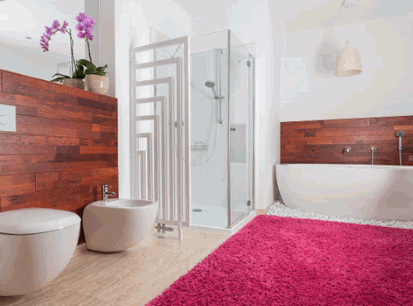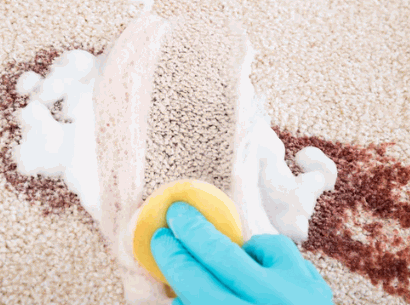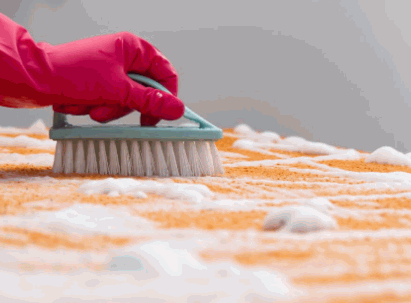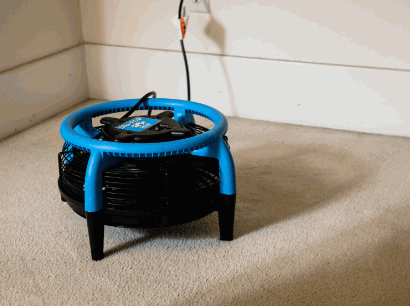Table Of Contents
A spic & span bathroom carpet is a must for a hygienic environment. It boosts the look of the bathroom and promotes good health. Ignoring its cleanliness can lead to the build-up of dirt, germs, and bad smells.
Vacuuming regularly is key to keeping a bathroom carpet clean. This removes dust, dirt, and debris which can accumulate over time. Also, using a carpet cleaner specifically designed for bathrooms is suggested. This helps to eliminate bacteria and stains effectively.
Apart from regular cleaning, there are some other points to remember. Place mats or towels near the shower/bath area to stop excess moisture from getting to the carpet. Also, quickly deal with any spills or accidents to avoid stains from setting in.
It's obvious that having a clean bathroom carpet is important for hygiene and looks. By following proper cleaning methods and being proactive to stop stains and moisture build-up, one can get a fresh and welcoming bathroom environment.

Preparing For Cleaning
To prepare for cleaning your bathroom carpet effectively, gather the necessary materials and tools as a solution. Additionally, clear the bathroom floor for easy access.
Gathering The Necessary Materials And Tools
- Create a list of tools and materials for cleaning. This includes solutions, brushes, sponges, cloths, gloves, and any other required items.
- Check the supplies you have on hand to save money.
- Store cleaning materials in an area or storage space. It'll make cleaning easier.
- Use eco-friendly or natural products when you can. They're safer and more effective.
- Prioritize high-quality tools that last. They may be expensive but they will save you money in the long run.
- Get ladders, cords, or safety gear if needed for tasks like window cleaning.
- These steps guarantee excellent results.
- Check unique needs based on the task.
- Regularly update the list of supplies to stay organized.
- Research and find suitable brands and types of cleaning solutions.
- Use apps or tools to create lists and set reminders for restocking.
- Use reusable containers to reduce waste.
- Optimize storage with shelves or cabinets.
- Keep hazardous chemicals out of reach and in well-ventilated areas.
- Follow these tips for an efficient cleaning routine and sustainability.

Clearing The Bathroom Floor For Easy Access
- Begin cleaning by taking out any towels, mats, or objects from the floor. This will help with cleaning and stop you from slipping or tripping.
- Empty the bathroom trash bin. This will create more space and prevent bad smells.
- Neatly organize toiletries like shampoo bottles, soap, and toothbrush holders. Cleaning will be easier and these won't get in the way.
- Sweep or vacuum the bathroom floor to stop debris from spreading while mopping. Pay attention to often forgotten areas like behind the toilet tank and under cabinets. These need extra effort but don't ignore them.
- Pro Tip: Use stackable containers to save vertical space in the bathroom cabinets. This will help the floor stay clear and make it easier to keep clean in the long run.

Vacuuming The Carpet
To efficiently vacuum the carpet in your bathroom, tackle the task of removing loose dirt and debris first. Then, make use of the various attachments available to reach those tricky areas. This thorough approach to vacuuming will ensure a clean and fresh bathroom carpet.

Removing Loose Dirt And Debris
Prep your vacuum cleaner! Ensure it's in good working order and the bag or canister is empty. Clear larger objects or obstacles off carpets, so your vacuum cleaner won't get damaged. Vacuum using long, overlapping strokes in a pattern across the carpet. Pay extra attention to high-traffic areas and places where dirt accumulates, like near entryways and under furniture.
Invest in a vacuum cleaner with a HEPA filter for better air quality. This filter traps smaller particles that regular vacuums miss, improving air in the home.
Understand why each suggestion works. Clearing objects prevents clogs and damage to the machine. Long, overlapping strokes clean carpet fibers and cover the whole area. Focusing on high-traffic areas removes dirt and extends the life of your carpet.
Follow these steps for a healthier living environment and for removing loose dirt from your carpet.
Using Attachments For Hard-To-Reach Areas
The crevice tool is perfect for reaching between couch cushions or along baseboards. The brush attachment is great for upholstery and curtains. Its soft bristles remove dust and pet hair.
The extension wand is ideal for high places like ceiling fans or bookshelves. It avoids straining.
The pet hair attachment collects stubborn pet hair from carpets and furniture. The floor brush attachment is perfect for hardwood or tile floors. Its soft bristles won't damage the flooring.
Remember to clean the attachments regularly for efficiency. Refer to the manufacturer's instructions for proper usage and care.
Discover: How To Keep Carpet Clean In Dining Room
Treating Stains And Spots
To effectively treat stains and spots on your bathroom carpet, turn to this section on "Treating Stains and Spots." Learn how to identify specific stains and the appropriate cleaning methods to tackle them. Additionally, explore the options of using homemade or store-bought carpet stain removers for effective stain removal.
Identifying Specific Stains And Appropriate Cleaning Methods
Let's investigate this table. It outlines what to do for certain spots.
| Stain | Cleaning Method |
|---|---|
| Red Wine | Salt, club soda |
| Coffee | Dish soap, white vinegar |
| Ink | Rubbing alcohol |
| Grass | Liquid detergent, cold water |
| Grease | Dish soap, warm water |
| Blood | Hydrogen peroxide |
Now let's examine some extra details.
For red wine stains, it's vital to be fast. Blot with a cloth or paper towel. Sprinkle salt to take in wetness then treat with club soda.
With ink spots, rubbing alcohol works great to break down colors. Use a cotton ball or cloth and carefully pat the area.
Here are a few tips to remember:
- Blot, not rub: Rubbing will just make the stain worse. Use a clean cloth or paper towel.
- Test first: Test on an unnoticeable bit of fabric before applying any cleaning product.
- Act fast: Don't wait to treat a stain. The sooner, the better.
- Follow instructions: Different fabrics need different methods. Read all care instructions.
If you remember these tips and know how to manage stains, you can keep your stuff looking great.

Using Homemade Or Store-Bought Carpet Stain Removers
Always read the instructions on the label before using carpet stain remover! Blot the stain gently with a clean cloth and don't rub it. Fresh stains should be tackled quickly. Test homemade solutions on an inconspicuous area first. Different types of stains need different approaches. Some products have specific instructions for certain materials.
So, remember to follow instructions, act quickly, and select the right product for the stain. Using carpet stain removers can be a game-changer for your carpets!
Deep Cleaning The Carpet
To deep clean your bathroom carpet effectively, utilize carpet shampoo or cleaning solution and employ the technique of scrubbing the carpet with a brush or sponge. These two sub-sections provide simple yet effective solutions for achieving a thoroughly cleaned bathroom carpet.
Using Carpet Shampoo Or Cleaning Solution
Carpet shampoo or cleaning solution can be a key tool for deep cleaning carpets. It can get rid of dirt and spots, leaving carpets fresh and vibrant. Here’s how to use it:
- Take out furniture and objects from the carpet.
- Vacuum to remove dirt and debris.
- Dilute carpet shampoo or cleaning solution per instructions on the bottle.
- Use a clean sponge or brush to apply diluted solution to small sections.
- Gently scrub in circles, focusing on tough spots.
- Use a clean cloth or towel to blot away moisture and residue.
It's best to work in sections and not oversaturate. Different carpets need special shampoos or solutions, so check with the maker or hire a professional.
Scrubbing The Carpet With A Brush Or Sponge
- Pick a brush or sponge suited for your carpet type. For delicate carpets, use a soft-bristled brush or gentle sponge. For a more durable carpet, choose a stiff bristle brush.
- Vacuum the entire carpet to remove dirt and debris.
- Mix a carpet cleaning solution with warm water as per instructions.
- Dip the brush/sponge into the solution and scrub in circular motions. Focus on stained areas.
- Don't oversaturate the carpet as moisture can cause mold/mildew.
- Blot excess liquid with a clean cloth/towel.
- Try a stain remover if needed.
- Let the carpet dry before walking on it again.
- Open windows/use fans to speed up drying.

Rinsing And Drying The Carpet
To effectively rinse and dry your bathroom carpet, the key is to remove any residue and expedite the drying process. Thoroughly rinsing the carpet ensures the removal of any leftover cleaning product or dirt. Assisting the drying process with fans or open windows helps to speed up the evaporation and prevent mold or mildew growth.
Thoroughly Rinse The Carpet To Remove Any Residue
Thoroughly rinsing your carpet is key to a successful cleaning. Residue can come from cleaning solutions, spills, or just general dirt and grime over time. Rinsing helps to get rid of all traces of residue and leaves your carpet clean and fresh. Here's how:
- Get the cleaning solution ready: Mix a mild detergent with warm water in a bucket. Don't use harsh chemicals or bleach - they'll damage the carpet fibers.
- Test an area out: Before applying the whole carpet, try it on a small corner or hidden area to make sure it won't discolor or damage it.
- Apply the solution: Pour the cleaning solution onto a sponge or cloth and dab the stained areas. Don't scrub vigorously as it'll push dirt deeper into the fibers.
- Rinse with clean water: When done, use a clean sponge soaked in plain water to blot away the detergent from the carpet. Repeat until no soapy residue is left.
For an even deeper clean, here are some extra tips:
- Use a wet-dry vacuum: After rinsing, use a wet-dry vac to extract excess moisture. This will speed up drying time and stop mold or mildew growth.
- Allow time to dry: Make sure your carpet has enough time to dry before putting furniture back on it or walking over it. Ample ventilation helps with quicker drying.
- Professional cleaning: If the carpet is heavily stained or has tough residue, hire professional carpet cleaners. They have the expertise and equipment to properly rinse and dry your carpet.
These suggestions can help you get your carpets sparkling clean and make them last longer. So go ahead and give your carpets the attention they deserve for a fresh and inviting space.
Assisting The Drying Process With Fans Or Open Windows
Fans and open windows can help you dry your carpet faster. Here's what to keep in mind:
- Position fans around the carpeted area to enhance airflow.
- Pick fans with adjustable speeds for better control.
- Open windows to get extra air and moisture out.
- In humid areas, use dehumidifiers too.
- Maintain a humidity range of 40-60%.
- Keep electrical appliances away from water.
Time is of the essence! Start drying your carpet ASAP post-cleaning or rinsing. This can prevent mold and ensure speedy results.

Tips For Maintaining A Clean Bathroom Carpet
To maintain a clean bathroom carpet and keep it looking fresh, incorporate these tips. Regular vacuuming and spot cleaning will help remove dirt and prevent stains. Using doormats or rugs outside the bathroom will also minimize the amount of dirt that enters the space.
Regular Vacuuming And Spot Cleaning
Vacuum your carpet once a week to get rid of dirt, dust, and debris. Use a handheld vacuum or a brush attachment for hard-to-reach places. When you spot a spill or stain, soak up the liquid with a clean cloth or paper towel and use an appropriate cleaning solution. Avoid using harsh chemicals or bleach as these can damage the fibers. For mold or mildew, mix vinegar and water and scrub the area gently. Put a rubber-backed bath mat on top of the carpet to prevent moisture and stains.
Also, remember to regularly wash the bath mat, shower curtain, and other items that come into contact with the carpet. Get professional steam cleaning every now and then to deep clean the bathroom carpet and restore its fibers. To make your bathroom smell fresh, sprinkle baking soda on the carpet before vacuuming.
Using Doormats Or Rugs Outside The Bathroom To Prevent Dirt From Entering
Invest in a doormat for the bathroom entrance. Its coarse texture will trap dirt and debris. Place a rug outside the door too - it's stylish and has the added benefit of blocking dirt and moisture. Put a small mat or rug near the sink, to absorb water spills or drips.
Not only practical, these mats and rugs can also make your bathroom look great. Pick designs and colors that match your bathroom theme. Clean these floor coverings regularly, to keep your bathroom clean and hygienic.

Conclusion: Enjoying A Fresh And Clean Bathroom Carpet
Indulge in the satisfaction of having a clean bathroom carpet! It's essential to keep your space hygienic and pleasant. Clean your carpet regularly to banish dirt, stains, and odors.
- Start by vacuuming. Get all the corners and edges for hidden particles.
- Tackle stains and spills with a cleaning solution and a soft brush. Scrub the spots until they disappear.
In addition to regular cleaning, periodically deep clean your carpet. Use steam or shampooing for deep-seated dirt and grime. Leave the carpet looking and feeling revitalized.
To keep your bathroom carpet clean, use a waterproof mat underneath. This prevents moisture from seeping in and reduces the chance of mold or mildew growth.
Follow these easy steps and enjoy a fresh and clean carpet for years! Don't miss out on hygienic living space - act now and give your bathroom carpet the care it deserves!


